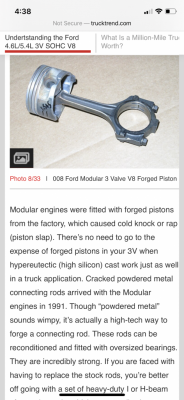Toby is pretty backwards in a lot of his opinions. Fact is metallurgy has gotten a lot better in the last 25 years and engines last longer. The Modular V8 is built a lot stronger than the Windsor series pushrod V8 engine it replaced, that is evident just by looking at the main caps/bolts and the block itself.
Not really. We can all nitpick certain things that show either positive or negative. The modular engines were great engines. They had them perfected by right around 96 to 97. These go 300-plus Thousand Miles without ever having a valve cover off. They are great. Now with the three valves they are not so great anymore. They have to have timing chains and cam phasers replaced often head under a hundred twenty five thousand. I understand I think it's you who have had three or four of them with no problems but as you start researching there are a lot of people with problems. Sure the percentages are still pretty low but with the millions of these on the roads a lot of people have problems with the timing components and cam phasers. This simply did not happen on the two valve motor. Same basic design but things have changed some. This is actually not a metallurgical problem. They didn't cheap and anything to cause the problem. This was about because for fuel mileage and infinitely or constantly variable valve timing Etc. The Honda VTEC was one of the first engines commonly in America to have variable valve timing but it was a much more simplistic design with only two positions. It really gave any problems.
Let's talk about firearm manufacturer parts being made out of PIM metal, then tell me that metallurgy is better than it was 20 years ago.
But as I said, this is just another example of us being able to nitpick certain things that are better or certain things that are worse.
Overall, the longevity and durability of engines in cars improved a lot from from the cars in the 60s through late 80s.
The ones built from the late 80s on we're much better then these older decades. Now, for many of them the trend is going the other way.
It's not quite an epidemic yet but it's getting to epidemic proportions.
Forged steel connecting rods are not better today than they were 25 years ago! In fact, it's hard to get as good of quality iron or steel as it was 25 or 30 years ago. Most of the stuff is recycled and not as good as the old original stuff we had.
Expensive, high-performance block manufacturers are forced to buy steal from Chinese foundry's because there's no suppliers in the US supplying it from what I read just a few months ago.
They don't care about costs as the people buying their blocks will pay an extra few hundred to couple of thousand for the quality without asking any questions.
I read two or three different manufacturers who said they would have gladly paid more for us sourced Steel but there was none available. They often have problems with the quality of the import steel or forgings.
Technology does often improve things but sometimes when people are insistent on applying technology to tried-and-true things that already worked just fine, they introduce problems that then have to be overcome. Often you only get back to where you started from and sometimes you don't, and sometimes you end up a little better off. But almost always the end result is a little bit cheaper for them and that's what they're going for.
The only thing that's improved and they high performance race car world and aftermarket parts has been tolerances and replicating these tolerance is so part uniformity and consistency.
They have also improved valve sealing because of very minut an exact machinery. In the old days a 3 angle valve job was top-notch until like around 2000.
Now people consider that a joke. They have like 6 Plus sealing angles or whatever and if you were to do a 3 angle valve job on a newer set of heads you would be diminishing the performance and the sealing ability.
This has nothing to do with Metallurgy though or the quality of the valves or aluminum heads being machined.


